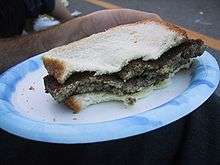Scrapple
 A plate of scrapple | |
| Alternative names | Pon haus, Krepples |
|---|---|
| Type | Pudding |
| Place of origin | United States |
| Region or state | Pennsylvania |
| Main ingredients | mush of pork, cornmeal, flour, buckwheat flour, spices |
Scrapple, also known by the Pennsylvania Dutch name Pannhaas or "pan rabbit",[1][2] is traditionally a mush of pork scraps and trimmings combined with cornmeal and wheat flour, often buckwheat flour, and spices. The mush is formed into a semi-solid congealed loaf, and slices of the scrapple are then pan-fried before serving. Scraps of meat left over from butchering, not used or sold elsewhere, were made into scrapple to avoid waste. Scrapple is best known as an American food of the Mid-Atlantic states (Delaware, Maryland, New Jersey, Pennsylvania, and Virginia). Scrapple and panhaas are commonly considered an ethnic food of the Pennsylvania Dutch, including the Mennonites and Amish. Scrapple is found in supermarkets throughout the region in both fresh and frozen refrigerated cases.
Composition
Scrapple is typically made of hog offal, such as the head, heart, liver, and other trimmings, which are boiled with any bones attached (often the entire head), to make a broth. Once cooked, bones and fat are removed, the meat is reserved, and (dry) cornmeal is boiled in the broth to make a mush. The meat, finely minced, is returned to the pot and seasonings, typically sage, thyme, savory, black pepper, and others are added.[3][4] The mush is formed into loaves and allowed to cool thoroughly until set. The proportions and seasoning are very much a matter of the region and the cook's taste.[5]
A few manufacturers have introduced beef[6] and turkey varieties and color the loaf to retain the traditional coloration derived from the original pork liver base.
Due to its composition, it is often jokingly described as being made from "everything but the oink".[7][8]
Preparation

Scrapple is typically cut into quarter-inch to three-quarter-inch slices and pan-fried until brown to form a crust. It is sometimes first coated with flour. It may be fried in butter or oil and is sometimes deep-fried. Scrapple can also be broiled; this is a good cooking method for those who like their scrapple crisp.
Scrapple is usually eaten as a breakfast side dish. It can be served plain or with either sweet or savory condiments: apple butter, ketchup, jelly, maple syrup, honey, or mustard.
History and regional popularity
The roots of the culinary traditions that led to the development of scrapple in America have been traced back to pre-Roman Europe.[9] The more immediate culinary ancestor of scrapple was the Low German dish called panhas, which was adapted to make use of locally available ingredients, and it is still called "Pannhaas," "panhoss," "ponhoss," or "pannhas" in parts of Pennsylvania.[10] The first recipes were created by German colonists who settled near Philadelphia and Chester County, Pennsylvania in the 17th and 18th centuries.[11] As a result, scrapple is strongly associated with areas surrounding Philadelphia, Baltimore, Washington, D.C.; Eastern Pennsylvania, New Jersey, Maryland, Delaware, Southern New York, and the Delmarva Peninsula. Its popularity on the Delmarva Peninsula is celebrated the second weekend of October during the annual "Apple Scrapple Festival" in Bridgeville, Delaware.
See also
Foods
- Balkenbrij, a traditional Dutch food that shares some of the characteristics of scrapple
- Faggot, an English dish made of meat off-cuts and offal, especially pork
- Goetta, a meat-and-grain sausage or mush of German inspiration, popular near Cincinnati
- Groaty pudding, in England, made from soaked groats, beef, leeks, onion and beef stock which is then baked
- Haggis, a traditional Scottish savory pudding containing sheep's pluck (heart, liver, and lungs), minced with onion, oatmeal, suet, spices, and salt, mixed with stock
- Haslet, in England, a pork meatloaf with herbs
- Livermush, in the United States, a dish of pig liver, head parts, and cornmeal
- Lorne sausage, a traditional Scottish food usually made from minced meat, rusk and spices
- Meatloaf, a dish of ground meat mixed with other ingredients and formed into a loaf shape, then baked or smoked
- Pork roll, pork-based processed meat available in parts of the northeastern United States
- Slatur, an Icelandic food made from the innards of sheep
- Weckewerk, in Germany, a sausage made from cooked brawn and minced meat, veal or sausage, and broth of pork, sometimes from cooked meat, blood and offal
References
- ↑ Pennsylvania Folklife 22. Pennsylvania Dutch Folklore Center. 1972. Retrieved 2014-05-30.
- ↑ Food in Colonial and Federal America. Greenwood Publishing Group, 2005. 2005. ISBN 9780313329883. Retrieved 2014-05-30.
- ↑ "Homemade Scrapple (PA Dutch Pon Haus) | Recipe from Teri's Kitchen". Teriskitchen.com. Retrieved 2011-04-10.
- ↑ "Scrapple Recipe". Food Network. Retrieved 2011-04-10.
- ↑ "About.com, PA and NJ Regional Recipes. Scrapple Recipes". Philadelphia.about.com. 2009-08-20. Archived from the original on 2011-07-07. Retrieved 2011-04-10.
- ↑ "Rappa Scrapple, Beef". Rapascrapple.com. Archived from the original on 2009-02-13. Retrieved 2011-04-10.
- ↑ Talorico, Patricia (May 21, 2014). "Scrapple – love or loathe the loaf". The News Journal. Retrieved July 9, 2018.
- ↑ Jalowitz, Alan (Spring 2013). "Scrapple: Pennsylvania's "Other" Meatloaf". Retrieved July 9, 2018 – via psu.edu.
Scrapple is but one of the many varieties of dishes that arose from the need for the poorer classes in society to use as much of their butchered hogs as possible. This frugality has given more than one wag cause to refer to scrapple as "everything but the oink."
- ↑ Weaver, William Roys (2003). Country Scrapple: An American Tradition. Stackpole Books. p. 8. ISBN 978-0-8117-0064-1.
- ↑ "Definition of "pannhas"". Dictionary.reference.com. Random House Unabridged Dictionary. 2006. Retrieved 2011-04-10.
- ↑ "Habbersett Scrapple Corporate Internet Site, History". Habbersettscrapple.com. Archived from the original on 2011-09-17. Retrieved 2011-04-10.